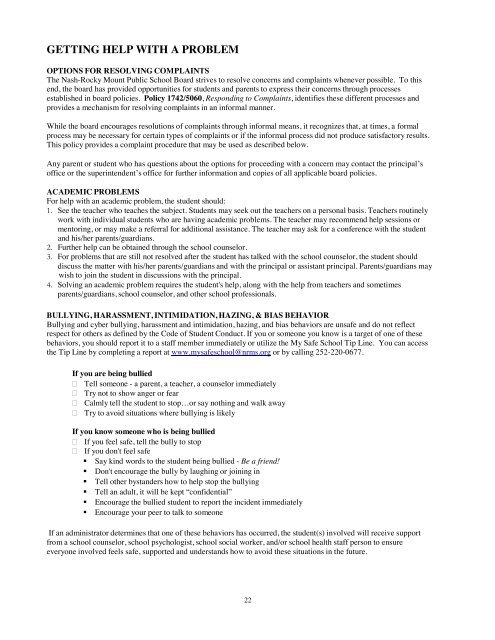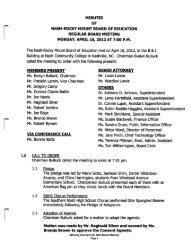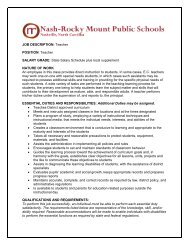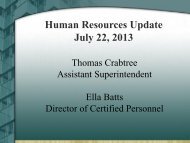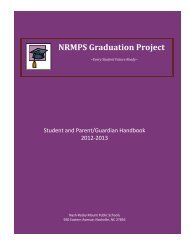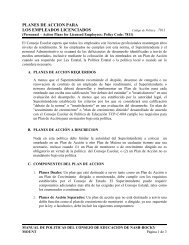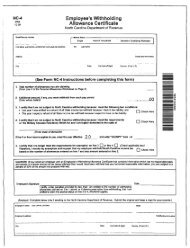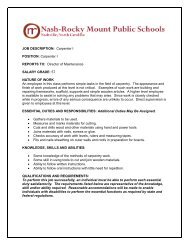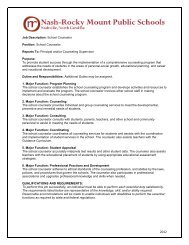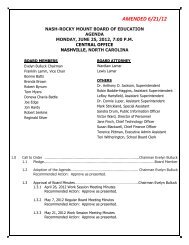2013-14 Student/Parent Handbook - Nash-Rocky Mount Schools
2013-14 Student/Parent Handbook - Nash-Rocky Mount Schools
2013-14 Student/Parent Handbook - Nash-Rocky Mount Schools
You also want an ePaper? Increase the reach of your titles
YUMPU automatically turns print PDFs into web optimized ePapers that Google loves.
GETTING HELP WITH A PROBLEM<br />
OPTIONS FOR RESOLVING COMPLAINTS<br />
The <strong>Nash</strong>-<strong>Rocky</strong> <strong>Mount</strong> Public School Board strives to resolve concerns and complaints whenever possible. To this<br />
end, the board has provided opportunities for students and parents to express their concerns through processes<br />
established in board policies. Policy 1742/5060, Responding to Complaints, identifies these different processes and<br />
provides a mechanism for resolving complaints in an informal manner.<br />
While the board encourages resolutions of complaints through informal means, it recognizes that, at times, a formal<br />
process may be necessary for certain types of complaints or if the informal process did not produce satisfactory results.<br />
This policy provides a complaint procedure that may be used as described below.<br />
Any parent or student who has questions about the options for proceeding with a concern may contact the principal’s<br />
office or the superintendent’s office for further information and copies of all applicable board policies.<br />
ACADEMIC PROBLEMS<br />
For help with an academic problem, the student should:<br />
1. See the teacher who teaches the subject. <strong>Student</strong>s may seek out the teachers on a personal basis. Teachers routinely<br />
work with individual students who are having academic problems. The teacher may recommend help sessions or<br />
mentoring, or may make a referral for additional assistance. The teacher may ask for a conference with the student<br />
and his/her parents/guardians.<br />
2. Further help can be obtained through the school counselor.<br />
3. For problems that are still not resolved after the student has talked with the school counselor, the student should<br />
discuss the matter with his/her parents/guardians and with the principal or assistant principal. <strong>Parent</strong>s/guardians may<br />
wish to join the student in discussions with the principal.<br />
4. Solving an academic problem requires the student's help, along with the help from teachers and sometimes<br />
parents/guardians, school counselor, and other school professionals.<br />
BULLYING, HARASSMENT, INTIMIDATION, HAZING, & BIAS BEHAVIOR<br />
Bullying and cyber bullying, harassment and intimidation, hazing, and bias behaviors are unsafe and do not reflect<br />
respect for others as defined by the Code of <strong>Student</strong> Conduct. If you or someone you know is a target of one of these<br />
behaviors, you should report it to a staff member immediately or utilize the My Safe School Tip Line. You can access<br />
the Tip Line by completing a report at www.mysafeschool@nrms.org or by calling 252-220-0677.<br />
If you are being bullied<br />
Tell someone - a parent, a teacher, a counselor immediately<br />
Try not to show anger or fear<br />
Calmly tell the student to stop…or say nothing and walk away<br />
Try to avoid situations where bullying is likely<br />
If you know someone who is being bullied<br />
If you feel safe, tell the bully to stop<br />
If you don't feel safe<br />
•Say kind words to the student being bullied - Be a friend!<br />
•Don't encourage the bully by laughing or joining in<br />
•Tell other bystanders how to help stop the bullying<br />
•Tell an adult, it will be kept “confidential”<br />
•Encourage the bullied student to report the incident immediately<br />
•Encourage your peer to talk to someone<br />
If an administrator determines that one of these behaviors has occurred, the student(s) involved will receive support<br />
from a school counselor, school psychologist, school social worker, and/or school health staff person to ensure<br />
everyone involved feels safe, supported and understands how to avoid these situations in the future.<br />
22


